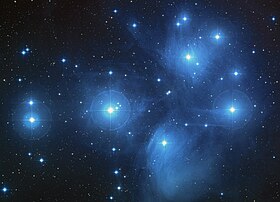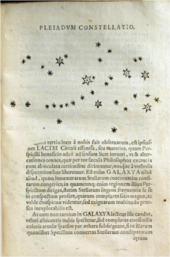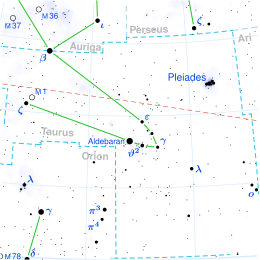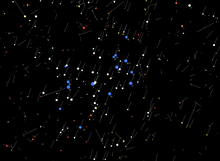| Pleiades | |
|---|---|
|
A color-composite image of the Pleiades from the Digitized Sky Survey
Credit: NASA/ESA/AURA/Caltech | |
| Observation data (J2000 epoch) | |
| Constellation | Taurus |
| Right ascension | 03h 47m 24s |
| Declination | +24° 07′ 00″ |
| Distance | 444 ly on average (136.2±1.2 pc) |
| Apparent magnitude (V) | 1.6 |
| Apparent dimensions (V) | 110' (arcmin) |
| Physical characteristics | |
| Other designations | M45, Seven Sisters, Melotte 22 |
The Pleiades, also known as the Seven Sisters and Messier 45, are an open star cluster containing middle-aged, hot B-type stars located in the constellation of Taurus. It is among the nearest star clusters to Earth and is the cluster most obvious to the naked eye in the night sky.
The cluster is dominated by hot blue and luminous stars that have formed within the last 100 million years. Reflection nebulae around the brightest stars were once thought to be left over material from the formation of the cluster, but are now considered likely to be an unrelated dust cloud in the interstellar medium through which the stars are currently passing.
Computer simulations have shown that the Pleiades were probably formed from a compact configuration that resembled the Orion Nebula. Astronomers estimate that the cluster will survive for about another 250 million years, after which it will disperse due to gravitational interactions with its galactic neighborhood.
Origin of name
The name of the Pleiades comes from Ancient Greek. It probably derives from plein ("to sail") because of the cluster's importance in delimiting the sailing season in the Mediterranean Sea: "the season of navigation began with their heliacal rising". However, in mythology the name was used for the Pleiades, seven divine sisters, the name supposedly deriving from that of their mother Pleione
and effectively meaning "daughters of Pleione". In reality, the name of
the star cluster almost certainly came first, and Pleione was invented
to explain it.
Folklore and mythology
The Nebra sky disk, dated circa 1600 BC. The cluster of dots in the upper right portion of the disk is believed to be the Pleiades.
The Pleiades are a prominent sight in winter in the Northern Hemisphere, and are easily visible out to mid-Southern latitudes. They have been known since antiquity to cultures all around the world, including the Celts, Hawaiians (who call them Makaliʻi ), Māori (who call them Matariki), Aboriginal Australians (from several traditions), the Persians, the Arabs (who called them Thurayya ), the Chinese (who called them 昴 mǎo), the Quechua, the Japanese, the Maya, the Aztec, the Sioux, the Kiowa, and the Cherokee. In Hinduism, the Pleiades are known as Krittika and are associated with the war-god Kartikeya. They are also mentioned three times in the Bible
.
Galileo's drawings of the Pleiades star cluster from Sidereus Nuncius. Image courtesy of the History of Science Collections, University of Oklahoma Libraries.
The earliest known depiction of the Pleiades is likely a Northern German bronze age artifact known as the Nebra sky disk, dated to approximately 1600 BC. The Babylonian star catalogues name the Pleiades MULMUL (𒀯𒀯),
meaning "stars" (literally "star star"), and they head the list of
stars along the ecliptic, reflecting the fact that they were close to
the point of vernal equinox
around the 23rd century BC. The Ancient Egyptians may have used the
names "Followers" and "Ennead" in the prognosis texts of the Calendar of
Lucky and Unlucky Days of papyrus Cairo 86637. Some Greek astronomers considered them to be a distinct constellation, and they are mentioned by Hesiod's Works and Days, Homer's Iliad and Odyssey, and the Geoponica. Some scholars of Islam suggested that the Pleiades (ath-thurayya) are the "star" mentioned in Sura An-Najm ("The Star") of the Quran.
In Japan, the constellation is mentioned under the name Mutsuraboshi ("six stars") in the 8th century Kojiki. The constellation is now known in Japan as Subaru ("to unite"). It was chosen as the brand name of Subaru automobiles to reflect the origins of the firm as the joining of five companies, and is depicted in the firm's six-star logo.
Observational history
Galileo Galilei was the first astronomer to view the Pleiades through a telescope.
He thereby discovered that the cluster contains many stars too dim to
be seen with the naked eye. He published his observations, including a
sketch of the Pleiades showing 36 stars, in his treatise Sidereus Nuncius in March 1610.
The Pleiades have long been known to be a physically related group of stars rather than any chance alignment. John Michell
calculated in 1767 that the probability of a chance alignment of so
many bright stars was only 1 in 500,000, and so surmised that the
Pleiades and many other clusters of stars must be physically related. When studies were first made of the stars' proper motions,
it was found that they are all moving in the same direction across the
sky, at the same rate, further demonstrating that they were related.
Charles Messier measured the position of the cluster and included it as M45 in his catalogue of comet-like objects, published in 1771. Along with the Orion Nebula and the Praesepe
cluster, Messier's inclusion of the Pleiades has been noted as curious,
as most of Messier's objects were much fainter and more easily confused
with comets—something that seems scarcely possible for the Pleiades.
One possibility is that Messier simply wanted to have a larger catalogue
than his scientific rival Lacaille, whose 1755 catalogue contained 42 objects, and so he added some bright, well-known objects to boost his list.
Edme-Sébastien Jeaurat then drew in 1782 a map of 64 stars of the Pleiades from his observations in 1779, which he published in 1786.
Distance
The distance to the Pleiades can be used as an important first step to calibrate the cosmic distance ladder.
As the cluster is so close to the Earth, its distance is relatively
easy to measure and has been estimated by many methods. Accurate
knowledge of the distance allows astronomers to plot a Hertzsprung-Russell diagram
for the cluster, which, when compared to those plotted for clusters
whose distance is not known, allows their distances to be estimated.
Other methods can then extend the distance scale from open clusters to
galaxies and clusters of galaxies, and a cosmic distance ladder can be
constructed. Ultimately astronomers' understanding of the age and future
evolution of the universe is influenced by their knowledge of the
distance to the Pleiades. Yet some authors argue that the controversy
over the distance to the Pleiades discussed below is a red herring, since the cosmic distance ladder
can (presently) rely on a suite of other nearby clusters where
consensus exists regarding the distances as established by Hipparcos and
independent means (e.g., the Hyades, Coma Berenices cluster, etc.).
Measurements of the distance have elicited much controversy. Results prior to the launch of the Hipparcos satellite generally found that the Pleiades were about 135 parsecs away from Earth. Data from Hipparcos yielded a surprising result, namely a distance of only 118 parsecs by measuring the parallax
of stars in the cluster—a technique that should yield the most direct
and accurate results. Later work consistently argued that the Hipparcos
distance measurement for the Pleiades was erroneous. In particular, distances derived to the cluster via the Hubble Space Telescope and infrared color-magnitude diagram fitting (so-called "spectroscopic parallax") favor a distance between 135 and 140 pc; a dynamical distance from optical interferometric observations of the Pleiad double Atlas favors a distance of 133–137 pc. However, the author of the 2007–2009 catalog of revised Hipparcos parallaxes reasserted that the distance to the Pleiades is ~120 pc and challenged the dissenting evidence. Recently, Francis and Anderson proposed that a systematic effect on Hipparcos parallax errors for stars in clusters biases calculation using the weighted mean and gave a Hipparcos parallax distance of 126 pc and photometric distance 132 pc based on stars in the AB Doradus, Tucana-Horologium, and Beta Pictoris
moving groups, which are all similar in age and composition to the
Pleiades. Those authors note that the difference between these results
can be attributed to random error.
More recent results using very-long-baseline interferometry (VLBI) (August 2014) and preliminary solutions using Gaia Data Release 1 (September 2016) and Gaia Data Release 2 (August 2018), determine distances of 136.2 ± 1.2 pc, 134 ± 6 pc 136.2 ± 5.0 pc, respectively. Although the Gaia Data Release 1 team was cautious about their result, the VLBI authors assert "that the Hipparcos measured distance to the Pleiades cluster is in error".
| Year | Distance (pc) | Notes |
|---|---|---|
| 1999 | 125 | Hipparcos |
| 2004 | 134.6 ± 3.1 | Hubble Fine guidance sensor |
| 2009 | 120.2 ± 1.9 | Revised Hipparcos |
| 2014 | 136.2 ± 1.2 | Very-long-baseline interferometry |
| 2016 | 134 ± 6 | Gaia Data Release 1 |
| 2018 | 136.2 ± 5 | Gaia Data Release 2 |
Composition
A map of the Pleiades
The cluster core radius is about 8 light years and tidal radius
is about 43 light years. The cluster contains over 1,000 statistically
confirmed members, although this figure excludes unresolved binary stars. Its light is dominated by young, hot blue stars,
up to 14 of which can be seen with the naked eye depending on local
observing conditions. The arrangement of the brightest stars is somewhat
similar to Ursa Major and Ursa Minor. The total mass contained in the cluster is estimated to be about 800 solar masses and is dominated by fainter and redder stars.
The cluster contains many brown dwarfs, which are objects with less than about 8% of the Sun's mass, not heavy enough for nuclear fusion
reactions to start in their cores and become proper stars. They may
constitute up to 25% of the total population of the cluster, although
they contribute less than 2% of the total mass.
Astronomers have made great efforts to find and analyse brown dwarfs in
the Pleiades and other young clusters, because they are still
relatively bright and observable, while brown dwarfs in older clusters
have faded and are much more difficult to study.
Brightest stars
The nine brightest stars of the Pleiades are named for the Seven Sisters of Greek mythology: Sterope, Merope, Electra, Maia, Taygeta, Celaeno, and Alcyone, along with their parents Atlas and Pleione. As daughters of Atlas, the Hyades were sisters of the Pleiades. The English name of the cluster itself is of Greek origin (Πλειάδες), though of uncertain etymology. Suggested derivations include: from πλεῖν plein, "to sail", making the Pleiades the "sailing ones"; from πλέος pleos, "full, many"; or from πελειάδες peleiades, "flock of doves". The following table gives details of the brightest stars in the cluster:
| Name | Pronunciation | Designation | Apparent magnitude | Stellar classification |
|---|---|---|---|---|
| Alcyone | /ælˈsaɪ.əni/ al-SY-ə-nee | Eta (25) Tauri | 2.86 | B7IIIe |
| Atlas | /ˈætləs/ AT-ləs | 27 Tauri | 3.62 | B8III |
| Electra | /ɪˈlɛktrə/ i-LEK-trə | 17 Tauri | 3.70 | B6IIIe |
| Maia | /ˈmeɪ.ə, |
20 Tauri | 3.86 | B7III |
| Merope | /ˈmɛrəpi/ MERR-ə-pee | 23 Tauri | 4.17 | B6IVev |
| Taygeta | /teɪˈɪdʒɪtə/ tay-IJ-i-tə | 19 Tauri | 4.29 | B6V |
| Pleione | /ˈplaɪ.əni/ PLY-ə-nee | 28 (BU) Tauri | 5.09 (var.) | B8IVpe |
| Celaeno | /sɪˈliːnoʊ/ si-LEE-noh | 16 Tauri | 5.44 | B7IV |
| Sterope, Asterope | /(ə)ˈstɛrəpi/ (ə)-STERR-ə-pee | 21 and 22 Tauri | 5.64;6.41 | B8Ve/B9V |
| — | — | 18 Tauri | 5.66 | B8V |
Age and future evolution
Stars of Pleiades with color and 10,000 year backwards proper motion shown
Ages for star clusters can be estimated by comparing the Hertzsprung–Russell diagram for the cluster with theoretical models of stellar evolution.
Using this technique, ages for the Pleiades of between 75 and 150
million years have been estimated. The wide spread in estimated ages is a
result of uncertainties in stellar evolution models, which include
factors such as convective overshoot, in which a convective zone within a star penetrates an otherwise non-convective zone, resulting in higher apparent ages.
Another way of estimating the age of the cluster is by looking at the lowest-mass objects. In normal main-sequence stars, lithium is rapidly destroyed in nuclear fusion reactions. Brown dwarfs can retain their lithium, however. Due to lithium's very low ignition temperature of 2.5 × 106
K, the highest-mass brown dwarfs will burn it eventually, and so
determining the highest mass of brown dwarfs still containing lithium in
the cluster can give an idea of its age. Applying this technique to the
Pleiades gives an age of about 115 million years.
The cluster is slowly moving in the direction of the feet of what is currently the constellation of Orion.
Like most open clusters, the Pleiades will not stay gravitationally
bound forever. Some component stars will be ejected after close
encounters with other stars; others will be stripped by tidal
gravitational fields. Calculations suggest that the cluster will take
about 250 million years to disperse, with gravitational interactions
with giant molecular clouds and the spiral arms of our galaxy also hastening its demise.
Reflection nebulosity
Hubble Space Telescope image of reflection nebulosity near Merope (IC 349)
With larger telescopes, the nebulosity around some of the stars can
be easily seen; especially when long-exposure photographs are taken.
Under ideal observing conditions, some hint of nebulosity around the
cluster may even be seen with small telescopes or average binoculars. It
is a reflection nebula, caused by dust reflecting the blue light of the hot, young stars.
It was formerly thought that the dust was left over from the formation
of the cluster, but at the age of about 100 million years generally
accepted for the cluster, almost all the dust originally present would
have been dispersed by radiation pressure. Instead, it seems that the cluster is simply passing through a particularly dusty region of the interstellar medium.
Studies show that the dust responsible for the nebulosity is not
uniformly distributed, but is concentrated mainly in two layers along
the line of sight to the cluster. These layers may have been formed by
deceleration due to radiation pressure as the dust has moved towards the stars.
Possible planets
Analyzing deep-infrared images obtained by the Spitzer Space Telescope and Gemini North telescope, astronomers discovered that one of the cluster's stars – HD 23514,
which has a mass and luminosity a bit greater than that of the Sun, is
surrounded by an extraordinary number of hot dust particles. This could
be evidence for planet formation around HD 23514.







